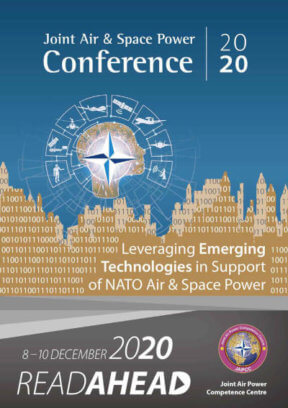Introduction
Leveraging existing and emerging technologies is one of the Allied Command Transformation challenges, along the Innovation and Technology path of Warfare Development in NATO. ‘Experimentation and Demonstration’ is one of the work strands that accentuates the need to invest time and resources toward the capability development process.1
The German Air Force took the enterprising approach of leveraging Artificial Intelligence (AI) technologies and commissioned a study undertaken by Subject Matter Experts (SMEs) from the German and French Air Forces, NATO ACT, and the JAPCC. Initiated in late 2017, the study formed with the ambition of investigating the development and use of AI in the Air Command and Control (AirC2) planning cycle in a Joint Force Air Component (JFAC).
Between the two main stakeholders, Germany and France, the combined expectation was that AI would free-up human resources during JFAC training and/or exercises, as well as create options during planning, thus speeding up the process.
The study was expanded on 1 November 2018 when a contract was awarded to CAE2 to provide deliverables such as analysis, a demonstrator, and progress reports.
The working title of the study is ‘AI in AirC2 Planning & Education, Training, Exercise and Evaluation (ETEE)’. The study explores the human-centred approach to overcome the challenges in the planning and execution phases of the JFAC planning cycle.
The Planner
The human participants in this study, planners assigned to the JFAC, needed to be observed in their working environment to understand the challenges they face, and how those challenges could be reduced to their simplest form most effectively.
The SMEs conducting the study observed and questioned the staff in the different JFAC divisions and branches during a high-intensity exercise in 2019, and collected information on the challenges of the different planners throughout the process. The information was collected using a combination of empirical data and performance-interviews conducted in all branches. Several planning branches were identified as potential candidates for further study. Some of them, such as Electronic Warfare and Defensive Fighter Operations planning, were identified to be very challenging, but the most stressful3 workload for planners was recognised to be the offensive Composite Air Operations (COMAO) planning. The scarcity of COMAO planners, the time constraints during planning and the considerable amount of data necessary for the process, this consequently became the primary focus of the study.
Why is the COMAO planning a suitable target for study? COMAO planning normally requires a lot of different resources4 in a short period of time, which makes it the most time- and capability-constrained activity for the JFAC, and it is as complex as it is demanding. It is challenging for the human planners, so the ambition, therefore, is to provide an AI agent. It may be described as a software that gathers information about an environment and takes action based on that information5. The AI agent must be taught the necessary knowledge and models to create a variety of COMAOs, thereby increasing options and improving the recommendation to the commander. The agent is defined by the type of application available and best suited for purpose, which, in this case, is Reinforced Learning.6 The way an AI agent learns, can be supervised or unsupervised. In this case, the supervised learning will place a human in the loop. The supervised learning portion will consist of professional COMAO operators/planners regularly testing and checking the agents learning method.
Reinforced Learning, simply explained, is a method of learning that includes sensation, action and goal. The agent interacts with its environment (sensation), explores and exploits it (acts), and is rewarded for solving the given task (goal). The agent will search for the optimal outcome (many times) to get as much reward as possible. The agent in this study will be fed well defined COMAO parameters in an environment (in this case the ICC system7: COMMAND) which it will use to try to exploit and win the air battle over an opponent. It will execute this process recognising why it is winning while indicating the choices made for its actions.
The goal of creating the best plans begin with understanding the performance of the best planners. In that sense, the best planner is a persona8 that performs, or behaves, in a certain way in order to further the plan. In the planning process, the persona’s (the agent) task must consist of either ‘Create Options’, calculate ‘Risk and Benefits’ or build ‘Situational Awareness’. ‘Create Options’ is respecting the study’s collective ambition and is, therefore, the selected persona.
During the study, the SMEs utilised the lens of the ‘Design Thinking process9’ to develop the persona of a ‘perfect planner’ (as in the best knowledgeable and experienced). This provided the framework idea of the best planning behaviour that an artificial agent would need. Behaviour, as a theme, is not (yet) easily produced in the AI world and cannot as such be demonstrated. However, this study will bridge the gap between the two planner types – the AI and the human planner.
To sum up, the focus of the study is to build a demonstrator, consisting of an agent that can create options in an Offensive COMAO scenario in order to assist planners and recommend options for the commander while showing the preferred actions/options.
When the human-centred approach is the most effective, it focuses on deep integration of humans into the data annotation process and into the real-world operation (optimizing both)10. The data annotation process involves the human selecting and prioritizing data from which the agent learns and optimizes the models. Before the agent is taught anything of the COMAO planning, the scope of the agent has to be defined by data (environment, program and network), policy (planes and flying/offensive parameters) and by setting the scenario – in this case a COMAO scenario.
The Commander’s Decision
The best outcome of any COMAO planning includes having several options, of which a chosen few are ultimately briefed to the commander. The commander then decides on his preferred option.
By the year 2021/2022, during the exercise Kalkar Sky11, the AI agent will have run and learned from thousands of COMAO-based scenarios in the given environment. The JFAC commander at Kalkar Sky will be presented with the agent’s recommendation and reasoning of actions of the COMAO plan based on the same available data, which the human planners will have at their disposal. It will be up to the commander to choose the recommendation to follow, the AI agent’s or the human planners’.
Will it be the perfect plan? Probably not. On the short term, the study will identify whether or not an agent will be able to develop a COMAO plan with the given data, meaning both the constraints and the restraints of the warring entities. What must the blue and the red forces do, and not do?
Should the German Air Force consider the agent to be of operational use, the technological future will look promising. It may expand to include another planning process (Defensive Fighter Ops or others), and when incorporating more than one component’s organic assets, the joint aspect might look promising as well. It may also be possible to fine-tune the planning to include denial and diversion and not only destruction operations.
The agent will need training in all characteristics of the air domain, and will always have the oversight of a human in the loop while doing so. This check ensures adherence to the legal aspects of the operations and, equally, validates the operational efficiency of the agent.
Future Outlook
The perfect planner, the skills of the persona, the rules of the planning, and a working knowledge of what comprises a COMAO all combine to provide an expert-level planner12. The AI agent’s strength is in adapting the skills and rules provided for a goal-oriented plan, not one that is process-oriented. In this case, you may say that the agent’s recommendation is provided with certainty, since it will be based on a lot of optimal outcome-planning. Expertise in a human is the combined behaviour of the previously recognized strengths fostering of fast decisions in complex situations and environments where there is a high degree of uncertainty. The human expert uses knowledge for reasoning in situations, which do not match previous experience. The AI agent at the current technological stage is not easily adaptable to that kind of reasoning to new situations (meaning new environments and different scenarios). Therefore, the agent will require extensive human assistance during its learning process, as well as validation during the final recommendation to be in line with current Rules of Engagements and Special Instructions. The ambition of this study in leveraging the AI technology in this JFAC planning situation might free up resources, add options, and possibly bring the German and French Air Force to the forefront of AI experimentation in military affairs.
Once it gets going, AI may be like a train that does not stop, and for that reason it will need to be recognized as an area that requires a regulatory framework and some kind of Standardisation Agreement(s) in NATO. Research and development are important as the forefront of the technology but should not be leading the principles of warfare and the development of doctrines adhering to that specific technology. The implications as well as opportunities and risks associated with the near AI future in warfare require more discussion, not only at the judicial level but also the ethical level. Others, not NATO, are leading the development of Artificial Intelligence strategy, according to the NATO Secretary-General Jens Stoltenberg13. This difference will most likely cause a significant capability gap if not appropriately dealt with.












